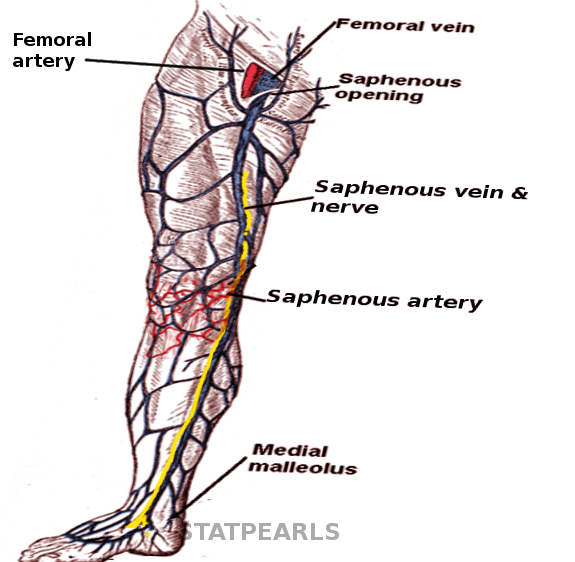[1]
Ramage JL, Varacallo M. Anatomy, Bony Pelvis and Lower Limb: Medial Thigh Muscles. StatPearls. 2023 Jan:():
[PubMed PMID: 30521196]
[2]
Bourne M, Talkad A, Varacallo M. Anatomy, Bony Pelvis and Lower Limb, Foot Fascia. StatPearls. 2023 Jan:():
[PubMed PMID: 30252299]
[4]
Uhl JF, Gillot C. Anatomy and embryology of the small saphenous vein: nerve relationships and implications for treatment. Phlebology. 2013 Feb:28(1):4-15
[PubMed PMID: 23256200]
[5]
Walters BB, Varacallo M. Anatomy, Bony Pelvis and Lower Limb: Thigh Sartorius Muscle. StatPearls. 2023 Jan:():
[PubMed PMID: 30422484]
[6]
Xu Q, Zheng X, Li Y, Zhu L, Ding Z. Anatomical Study of the Descending Genicular Artery Chimeric Flaps. Journal of investigative surgery : the official journal of the Academy of Surgical Research. 2020 Jun:33(5):422-427. doi: 10.1080/08941939.2018.1532541. Epub 2019 Mar 19
[PubMed PMID: 30884993]
[7]
Caggiati A, Bergan JJ. The saphenous vein: derivation of its name and its relevant anatomy. Journal of vascular surgery. 2002 Jan:35(1):172-5
[PubMed PMID: 11802151]
[8]
Shah DM, Chang BB, Leopold PW, Corson JD, Leather RP, Karmody AM. The anatomy of the greater saphenous venous system. Journal of vascular surgery. 1986 Feb:3(2):273-83
[PubMed PMID: 3944931]
[9]
Cantrell AJ, Imonugo O, Varacallo M. Anatomy, Bony Pelvis and Lower Limb: Leg Bones. StatPearls. 2023 Jan:():
[PubMed PMID: 30725709]
[10]
Hosahalli G, Sierakowski A, Venkatramani H, Sabapathy SR. Entrapment Neuropathy of the Infrapatellar Branch of the Saphenous Nerve: Treated by Partial Division of Sartorius. Indian journal of orthopaedics. 2017 Jul-Aug:51(4):474-476. doi: 10.4103/0019-5413.209954. Epub
[PubMed PMID: 28790478]
[11]
Marsland D, Dray A, Little NJ, Solan MC. The saphenous nerve in foot and ankle surgery: its variable anatomy and relevance. Foot and ankle surgery : official journal of the European Society of Foot and Ankle Surgeons. 2013 Jun:19(2):76-9. doi: 10.1016/j.fas.2012.10.007. Epub 2012 Dec 27
[PubMed PMID: 23548446]
[12]
Dayan V, Cura L, Cubas S, Carriquiry G. Surgical anatomy of the saphenous nerve. The Annals of thoracic surgery. 2008 Mar:85(3):896-900. doi: 10.1016/j.athoracsur.2007.11.032. Epub
[PubMed PMID: 18291167]
[13]
Mercer D, Morrell NT, Fitzpatrick J, Silva S, Child Z, Miller R, DeCoster TA. The course of the distal saphenous nerve: a cadaveric investigation and clinical implications. The Iowa orthopaedic journal. 2011:31():231-5
[PubMed PMID: 22096447]
[14]
Ekin EE, Kurtul Yildiz H. The importance of great saphenous vein types and segmental aplasia in venous reflux. Journal of clinical ultrasound : JCU. 2017 Jul 8:45(6):332-336. doi: 10.1002/jcu.22457. Epub 2017 Feb 10
[PubMed PMID: 28186621]
[15]
Goldman S, Zadina K, Moritz T, Ovitt T, Sethi G, Copeland JG, Thottapurathu L, Krasnicka B, Ellis N, Anderson RJ, Henderson W, VA Cooperative Study Group #207/297/364. Long-term patency of saphenous vein and left internal mammary artery grafts after coronary artery bypass surgery: results from a Department of Veterans Affairs Cooperative Study. Journal of the American College of Cardiology. 2004 Dec 7:44(11):2149-56
[PubMed PMID: 15582312]
[16]
Ozcan AV, Evrengul H, Goksin I, Gur S, Kaftan A. 30-year patency of a saphenous vein graft in coronary bypass graft surgery. The Annals of thoracic surgery. 2008 Apr:85(4):e23. doi: 10.1016/j.athoracsur.2008.01.069. Epub
[PubMed PMID: 18355484]
[17]
Harskamp RE, Lopes RD, Baisden CE, de Winter RJ, Alexander JH. Saphenous vein graft failure after coronary artery bypass surgery: pathophysiology, management, and future directions. Annals of surgery. 2013 May:257(5):824-33. doi: 10.1097/SLA.0b013e318288c38d. Epub
[PubMed PMID: 23574989]
Level 3 (low-level) evidence
[18]
Wilmot VV, Evans DJ. Categorizing the distribution of the saphenous nerve in relation to the great saphenous vein. Clinical anatomy (New York, N.Y.). 2013 May:26(4):531-6. doi: 10.1002/ca.22168. Epub 2012 Sep 19
[PubMed PMID: 22997057]
[19]
Pendergrass TL, Moore JH. Saphenous neuropathy following medial knee trauma. The Journal of orthopaedic and sports physical therapy. 2004 Jun:34(6):328-34
[PubMed PMID: 15233394]
[20]
Sipahioglu S, Zehir S, Sarikaya B, Levent A. Injury of the infrapatellar branch of the saphenous nerve due to hamstring graft harvest. Journal of orthopaedic surgery (Hong Kong). 2017 Jan:25(1):2309499017690995. doi: 10.1177/2309499017690995. Epub
[PubMed PMID: 28219309]
[21]
Figueroa D, Calvo R, Vaisman A, Campero M, Moraga C. Injury to the infrapatellar branch of the saphenous nerve in ACL reconstruction with the hamstrings technique: clinical and electrophysiological study. The Knee. 2008 Oct:15(5):360-3. doi: 10.1016/j.knee.2008.05.002. Epub 2008 Jun 26
[PubMed PMID: 18583136]
[22]
Portland GH, Martin D, Keene G, Menz T. Injury to the infrapatellar branch of the saphenous nerve in anterior cruciate ligament reconstruction: comparison of horizontal versus vertical harvest site incisions. Arthroscopy : the journal of arthroscopic & related surgery : official publication of the Arthroscopy Association of North America and the International Arthroscopy Association. 2005 Mar:21(3):281-5
[PubMed PMID: 15756180]
[23]
Espejo-Baena A, Golano P, Meschian S, Garcia-Herrera JM, Serrano Jiménez JM. Complications in medial meniscus suture: a cadaveric study. Knee surgery, sports traumatology, arthroscopy : official journal of the ESSKA. 2007 Jun:15(6):811-6
[PubMed PMID: 16758232]
[24]
Plasschaert F, Vandekerckhove B, Verdonk R. A known technique for meniscal repair in common practice. Arthroscopy : the journal of arthroscopic & related surgery : official publication of the Arthroscopy Association of North America and the International Arthroscopy Association. 1998 Nov-Dec:14(8):863-8
[PubMed PMID: 9848600]
[25]
Dunaway DJ, Steensen RN, Wiand W, Dopirak RM. The sartorial branch of the saphenous nerve: its anatomy at the joint line of the knee. Arthroscopy : the journal of arthroscopic & related surgery : official publication of the Arthroscopy Association of North America and the International Arthroscopy Association. 2005 May:21(5):547-51
[PubMed PMID: 15891719]
[26]
Gocmen-Mas N, Aksu F, Edizer M, Magden O, Tayfur V, Seyhan T. The arterial anatomy of the saphenous flap: a cadaveric study. Folia morphologica. 2012 Feb:71(1):10-4
[PubMed PMID: 22532178]
[27]
Horn JL, Pitsch T, Salinas F, Benninger B. Anatomic basis to the ultrasound-guided approach for saphenous nerve blockade. Regional anesthesia and pain medicine. 2009 Sep-Oct:34(5):486-9. doi: 10.1097/AAP.0b013e3181ae11af. Epub
[PubMed PMID: 19920424]
[28]
Labropoulos N, Summers KL, Sanchez IE, Raffetto J. Saphenous vein wall thickness in age and venous reflux-associated remodeling in adults. Journal of vascular surgery. Venous and lymphatic disorders. 2017 Mar:5(2):216-223. doi: 10.1016/j.jvsv.2016.11.003. Epub 2017 Jan 16
[PubMed PMID: 28214490]
